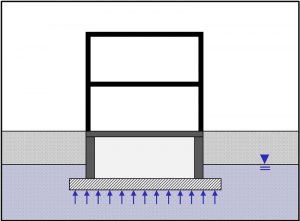
Is Hydrostatic Uplift an F or H?
Hydrostatic uplift occurs when a foundation is situated below a water table. We have received questions about hydrostatic uplift and if it should be an F or H load based on the following descriptions:
F: Load due to fluids with well-defined pressures and maximum heights, or
H: Load due to lateral earth pressure, ground water pressure, or pressure of bulk materials.
This is a significant area in which U.S. codes and standards are far from clear. We have researched a significant number of documents in which guidance, we felt, was likely to be available. Based on our research, our conclusion is hydrostatic uplift should be considered as a fluid load F with a load factor the same as that applied on dead load, D. Below is a detailed explanation.
It is our opinion that the word “lateral” in the definition for H applies to earth pressure, ground water pressure, as well as pressure of bulk materials. This is abundantly clear in ASCE 7-10 Commentary Section C2.3.2, where H is described as lateral pressure due to soil and water in soil.
The following exception to ASCE 7-05 Section 2.3.2 Basic [SD Load] Combinations makes sense only if H is lateral:
“2. The load factor on H shall be set equal to zero in combinations (6) and (7) if the structural action due to H counteracts that due to W or E. Where lateral earth pressure provides resistance to structural actions from other forces, it shall not be included in H but shall be included in the design resistance.”
We quote ASCE 7-05 above because the exception has been modified somewhat in substance in ASCE 7-10 and has been rewritten such that the point we want to make is not as evident.
What is less clear is how to account for hydrostatic uplift in the load combinations. Can we consider it as fluid load F for including in the load combinations?
The only mention of hydrostatic uplift in all of ASCE 7-10 is found in Section 3.2.2, which reads:
“3.2.2 Uplift on Floors and Foundations. In the design of basement floors and similar approximately horizontal elements below grade, the upward pressure of water, where applicable, shall be taken as the full hydrostatic pressure applied over the entire area. The hydrostatic load shall be measured from the underside of the construction. Any other upward loads shall be included in the design.”
ASCE 7-10 Commentary Section C2.3.2 suggests that F is typically caused by liquids stored in tanks and other vessels. Hydrostatic uplift is not clearly addressed at all in our codes and standards. However, while the Commentary does not go into this, there is really no fundamental difference between the upward pressure generated on a foundation by ground water and the downward pressure generated by the liquid inside a tank, which, according to the Commentary, can be utilized to overcome seismic uplift. If, we look at the definition of F, the hydrostatic pressure fits the definition (the density of water is fixed and well known), except that the maximum height may not be easy to establish with certainty. Here the guidance in Publication FHWA HI-98-032, Load and Resistance Factor Design (LRFD) for Highway Bridge Substructures, comes in handy. They are essentially recommending the use of a low water table when that is the conservative thing to do (for bearing), and a high water table when that is the conservative thing to do (in evaluating hydrostatic uplift).
The only place among all the documents reviewed, where we found clear direction as to how hydrostatic uplift is to be treated in the design load combinations is in the 1997 UBC, which says:
“1611.8 Hydrostatic Uplift. All foundations, slabs and other footings subjected to water pressure shall be designed to resist a uniformly distributed uplift load, F, equal to the full hydrostatic pressure.”
The upward-acting hydrostatic pressure is clearly identified as F. In the design load combinations of the 1997 UBC, which were based on those in ASCE 7-95, it was required that 1.3F, when applicable, be added presumably to every strength design load combination, and F be added to every ASD load combination. In contrast, ASCE 7-10 Section 2.3.2 says: “Where fluid loads F are present, they shall be included with the same load factor as dead load D…..”